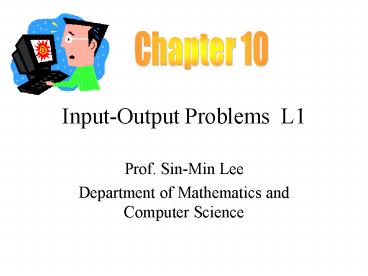Input-Output Problems L1 - PowerPoint PPT Presentation
1 / 50
Title:
Input-Output Problems L1
Description:
Synchronous - all state bits change at same time on a common clock. Buses. The buses that connect the three main parts of a computer system ... – PowerPoint PPT presentation
Number of Views:15
Avg rating:3.0/5.0
Title: Input-Output Problems L1
1
Input-Output Problems L1
Chapter 10
- Prof. Sin-Min Lee
- Department of Mathematics and Computer Science
2
(No Transcript)
3
(No Transcript)
4
(No Transcript)
5
(No Transcript)
6
(No Transcript)
7
(No Transcript)
8
(No Transcript)
9
(No Transcript)
10
(No Transcript)
11
(No Transcript)
12
Synchronous ----- all state bits change at same
time on a common clock.
13
(No Transcript)
14
Buses The buses that connect the three main parts
of a computer system are called the control bus,
the data bus and the address bus.
15
(No Transcript)
16
(No Transcript)
17
(No Transcript)
18
- A processor has a 24 bit address line and 8 bit
data line bus structure. - What is the maximum number of rows (cells) it can
address? - Answer 2 24 16777216 rows or cells (1 byte)
can be addressed independently - If the processor is word addressable only (one
word consisting of 2 bytes) what is the
addressable space) - Answer 16777216 words are addressable but only
one byte can be accessed because of the byte wide
data bus.
19
(No Transcript)
20
(No Transcript)
21
(No Transcript)
22
(No Transcript)
23
Sample Peripherals - I/O Transfer Rate
- The data transfer rate of the three peripherals
mentioned are as follow - Keyboard 10 bytes per second
- Hard drive 20 MB per second
- CRT 75 MB per second
24
I/O Interfaces
- CPU memory need special communication links to
resolve the differences in properties with
peripherals - 1. Peripherals are often electromechanical
devices whose manner of operation is different
from that of the CPU and memory, which are
electronic devices. Therefore, a conversion of
signal values may be requires
25
I/O Interfaces
- 2. The data transfer rate of peripherals is
usually different from the clock rate of the CPU.
Consequently, a synchronization mechanism may be
needed - 3. Data code and formats in peripherals differ
from the word format in the CPU and memory - 4. The operating modes of peripherals differ from
each other, and each must be controlled in a way
that does not disturb the operation of other
peripherals connected to the CPU
26
(No Transcript)
27
I/O Interfaces - Bus and Interface Unit
28
I/O Interfaces - Bus and Interface Unit
- Three ways that external computer buses
communicate with memory and I/O - Memory-mapped I/O
- Isolated I/O configuration
- Data channel
29
I/O Interfaces - Bus and Interface Unit
- Memory-mapped I/O
- Use common data, address, control bus for memory
and I/O - Isolated I/O configuration
- Use common data, address bus but different
control bus - Data channel
- Use two independent sets of data, address, and
control bus
30
I/O Interfaces - Bus and Interface Unit
- Data channel method is possible with computer
with I/O processor in addition to CPU - Memory communicate with CPU and I/O processor
through common memory bus
31
Example of I/O Interface
32
I/O Interfaces - Example of I/O Interface
- Control register
- Receives control information from CPU
- A bit in this register determine the operating
mode of the device
- Status register
- Contains bit to indicate status condition and
record any error during transfer
- Interface registers
- Communicate with CPU via bidirectional bus
33
- Data bus select the interface units through chip
select input (CS) and two register select (RS0)
and (RS1) - CPU and I/O devices are likely to have different
clock rate that are not synchronized - A control signal is needed to
- Indicate time the data is being transmitted
- Indicate the window of time when the address is
valid
34
I/O Interfaces - Example of I/O Interface
- Two methods to perform this timing between CPU
and devices - Strobing
- Handshaking
35
(No Transcript)
36
(No Transcript)
37
(No Transcript)
38
(No Transcript)
39
(No Transcript)
40
(No Transcript)
41
(No Transcript)
42
(No Transcript)
43
(No Transcript)
44
Interrupt
45
(No Transcript)
46
The memory address in the above table (column 3)
is the location of the handler routine that will
be executed as a result of the interrupt. Location
of table hardwired in machine, initialized by OS
47
(No Transcript)
48
(No Transcript)
49
(No Transcript)
50
(No Transcript)






























